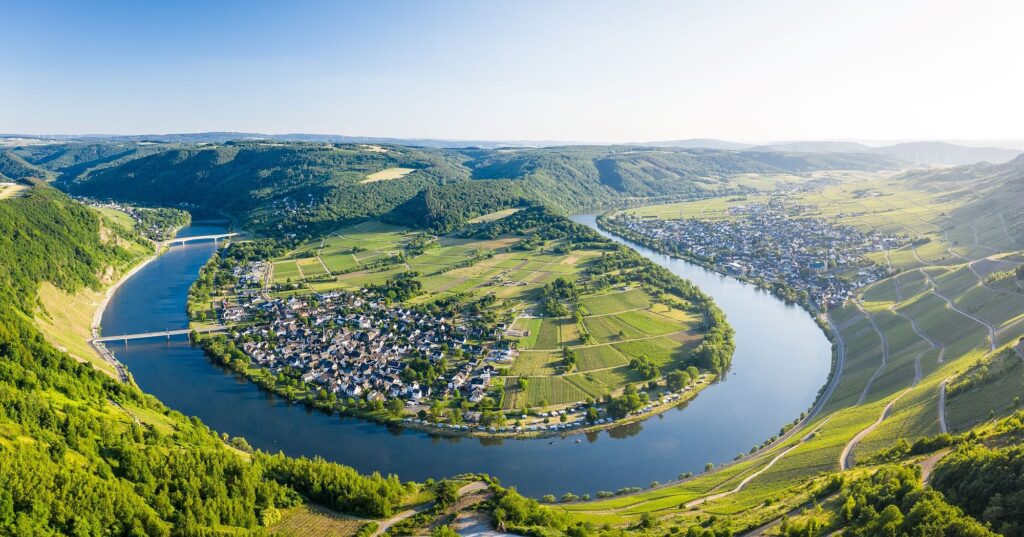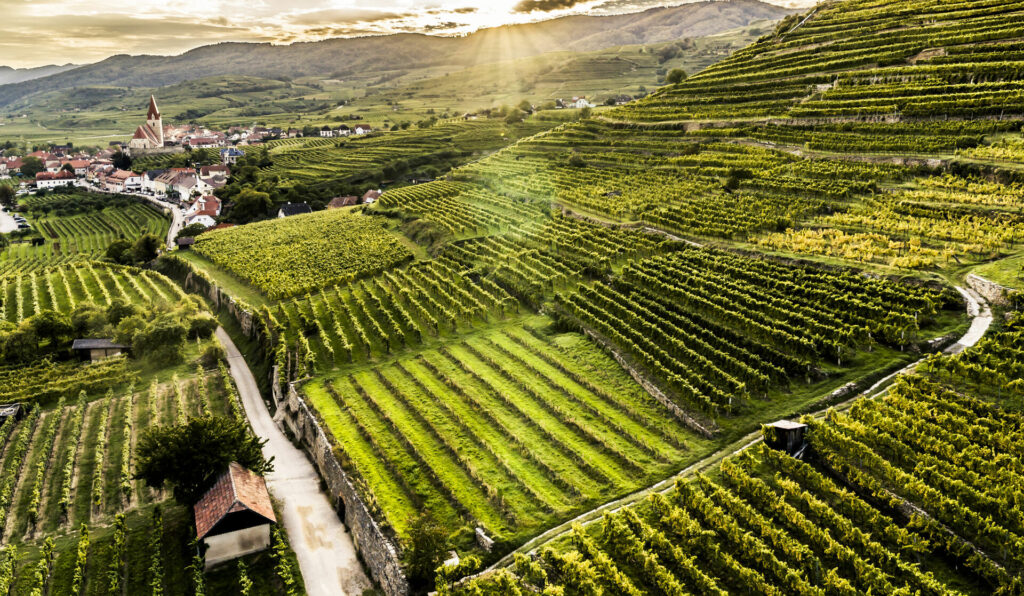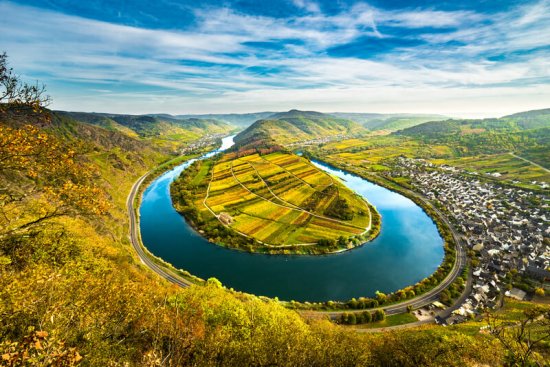Riesling – a favorite grape variety of sommeliers and wine experts
In terms of popularity and commercial success, Chardonnay and Sauvignon Blanc rule the white wine World, but on their heels are varieties such as Riesling and Chenin blanc. With its unmistakable combination of freshness, fruitiness and elegance, Riesling delights wine lovers all over the world. From dry, mineral wines to noble sweet wines, Riesling offers a remarkable variety that appeals to both beginners and experienced connoisseurs.
The first mentions of the grape variety date back to the 15th century in the wine-growing regions along the Rhine. Riesling has its roots in the Moselle, Rheingau and Pfalz regions in particular, where it finds ideal conditions to develop its full potential. The cool climates and mineral-rich soils of these regions contribute significantly to the development of the characteristic aromas that make Riesling so unique. Today, Riesling is successfully cultivated not only in Germany, but also in places like Alsace, Austria, Australia, New Zealand and the USA.
Riesling is particularly popular with sommeliers and wine critics. Jancis Robinson, MW, for example, says: “Riesling is arguably the finest white grape variety in the world, capable of producing wines of stunning intensity, longevity, and character from dry to lusciously sweet.” Stuart Pigott, British wine author and Riesling expert, adds: “No other white wine can offer such a complete, complex and exciting experience as a fine Riesling.” Why this enthusiasm? Here are the most important reasons:

- Diverse spectrum of aromas:
Riesling is characterized by an exceptionally broad spectrum of aromas. From notes of green apples, citrus fruits and stone fruit to floral aromas and complex mineral nuances – the range is enormous. This diversity enables sommeliers and wine critics to rediscover and describe the wines again and again, depending on their origin, ageing and vintage. With ageing, interesting petrol notes are added. These come from the element 1,1,6-trimethyl-1,2-dihydronaphthalenes (TDN) and arise because the Riesling grape forms so-called carotenoids at warmer temperatures, which are stored in the grape skin as protection against too much radiation. Above a certain concentration, this smells of petrol.
- Excellent expression of the terroir
Riesling is a grape variety that reflects the terroir, the specific climatic and geological conditions of the growing region, particularly well. Whether slate soils from the Moselle, calcareous soils from Alsace or volcanic soils from Austria: Riesling shows clear differences depending on its origin and makes the soil and climate tangible in the glass. This ability to convey the special characteristics of the growing region makes it particularly interesting for wine connoisseurs.
- Versatility in wine style
Riesling can be made in many different styles – from dry to semi-dry to noble sweet. This miscellany allows the wine to be paired with a wide range of dishes, from light, crisp Riesling for aperitifs to sweet Riesling that goes perfectly with cheeses and desserts. Sommeliers appreciate this flexibility, as it allows them to find a Riesling for almost any menu.
- Pronounced acid structure, moderate alcohol content
One of the most striking characteristics of Riesling is its lively acidity. This acidity gives the wine freshness, structure and excellent ageing potential. Even with sweet Rieslings, the acidity ensures that the wine never appears heavy or sticky, compared to Sauternes for example. The moderate alcohol content of Riesling supports this characteristic. The balanced acidity is a key element that wine critics appreciate, as it makes the wine lively and dynamic.
- Excellent ageing potential
Riesling is one of the few white wines that can age for decades. With increased age, complex aromas such as honey, dried fruit and, as mentioned, petrol develop, making the wine even more fascinating.
Why hasn’t Riesling been more successful commercially?
With all these qualitative strengths and despite active support from wine critics and sommeliers, why hasn’t dry Riesling become as commercially successful as Chardonnay and Sauvignon Blanc? Even the best dry Rieslings usually go for 50-80 EUR (let’s be happy while this is still the case). This question is hotly debated in specialist circles. The reasons often given are: 1. association with Germany, which is known for beer and not wine. 2. the association with sweet wines. This prevents consumers from thinking of Riesling when they want to drink a dry white. 3. the distinctive bottle shape “Schlegel” which inevitably brings to mind the two aforementioned attributes and cheap supermarket wines. 4. the characterful and fruity aroma, which is an acquired taste to some. It is difficult to say whether Riesling will make the breakthrough and join the group of the world’s most popular grape varieties or whether it will continue to stay mostly with aficionados like Chenin Blanc, Semillon, Viognier, Grüner Veltliner.
Wine Regions
Germany
Germany is the homeland of Riesling, making it the undisputed leader in producing premium wines. Germany’s top dry Rieslings come from several prestigious wine regions, each known for exceptional wines due to their unique soils, climate, and traditional viticulture. Here are the key regions famous for producing excellent dry Rieslings:

German Classification
In Riesling production, wines are classified by both quality level (similar to the French Grand Cru concept) and sweetness level. Unfortunately, these systems are not always consistently applied, so for a deeper understanding, it is worth exploring resources such as the VDP website. Here is a rule of thumb:
Quality Classification:
– Landwein
– Qualitätswein
– Prädikatswein
– Erste Lage
– Grosses Gewächs (GG) / Grosse Lage
Sweetness Classification:
- GG / Trocken – fully fermented. May taste slightly sweet compared to Sauvignon Blanc or Chardonnay due to Riesling’s natural fruity aromas at this concentration.
- Kabinett – slightly sweet, essentially off-dry. Great for an aperitif or with food.
- Spätlese – moderately sweet to medium sweet (also called feinherb), essentially off-dry, French term: Moelleux.
- Auslese – medium to sweet; the least reliable sweetness classification. To add to the confusion, the term “Auslese” is also used in its literal sense, as in “selection”, leading to dry Auslese wines as well.
- Beerenauslese – sweet to very sweet, essentially dessert wine, French term: Liquoreux.
- Trockenbeerenauslese (TBA) – very sweet, from grapes affected by Botrytis, similar to Sauternes.
- Eiswein – very sweet, from non-Botrytis grapes left on the vine to freeze.
German Sub-regions:
- Mosel / Saar / Ruwer: Germany’s top Riesling region, known for steep slopes with slate soils. While the Mosel is mainly known for its off-dry and sweet Rieslings, it also produces some of Germany’s best dry Rieslings from the steep slopes of Bernkastel, Piesport, Wehlen, and Scharzhofberg on the Saar. These wines often have lower alcohol levels but greater complexity, marked by pronounced minerality, crisp acidity, and flavors of green apple and citrus. Top producers include Markus Molitor, Fritz Haag, Clemens Busch, Heymann-Löwenstein, Schloss Lieser, Van Volxem, and Weiser Künstler. The region is also home to two renowned producers focused exclusively on off-dry wines: Joh. Jos. Prüm (Mosel) and Egon Müller (Saar).
- Nahe: An emerging region, still somewhat under-the-radar, nearly as cool as the Mosel. Diverse soils – from slate to volcanic rock to quartzite – allow for wines with a wide range of aromas and structures. Premier sites like Niederhausen, Schlossböckelheim, and Bad Kreuznach produce elegant, mineral-rich Rieslings with a harmonious balance of fruit and acidity. The leading producers are the Trinity of Dönnhoff, Emrich-Schönleber and Schäfer-Fröhlich.
- Rheingau: One of Germany’s most renowned Riesling regions, the Rheingau is regarded as the birthplace of dry Riesling, as it was warm enough to produce dry wines even before global warming. Vineyards lie along the Rhine and benefit from mild weather and sun-drenched slopes, particularly the steep vineyards around Rüdesheim, Assmannshausen, Kiedrich and Johannisberg. These wines feature fine minerality, elegant structure, and complex aromas of citrus and peach. Key producers include Robert Weil, Schloss Johannisberg, and Peter Jakob Kühn.
- Rheinhessen: Germany’s largest wine-growing region, which has evolved considerably in recent decades. Especially from the renowned “Rheinterrasse” sites near Nierstein and Oppenheim, world-class dry Rieslings are produced, known for their expressive character, intense fruit, and remarkable freshness. Rheinhessen is now a dynamic hub for modern, dry Rieslings. The leading producer here is Peter Keller with his famous (and famously expensive) Riesling G-Max, followed by Wittmann and Battenfeld-Spanier.
- Pfalz: Another major wine region, bordering the limit of Riesling’s ideal climate. Wines from Pfalz are fuller-bodied and richer. Notable vineyard areas near Deidesheim, Forst, and Dürkheim produce wines with intense fruit, spicy notes, and balanced acidity. Renowned producers include Bürklin-Wolf, Rebholz, Koehler-Ruprecht, Buhl, von Winning, and Müller-Catoir.
Alsace

Alsace is notably warmer and drier than most German regions, producing richer, oilier wines. This is also reflected in the region’s wider use of grape varieties. Pinot Gris, Gewürztraminer, and Muscat thrive here. About 90% of wines produced in Alsace are white. Like Champagne, Alsace has a high concentration of large, visible brands, many (around 1,200) growers sell to cooperatives or large houses. Alsace’s highest end is limited, as the region has traditionally prioritized volume over quality. The best wines come from hillside vineyards on the dry, sheltered side of the Vosges with distinct German-French names like:
- Ribeauvillé: Grand Cru vineyards such as Geisberg, Kirchberg, and Osterberg are noteworthy, featuring limestone and slate soils that produce wines of high minerality and complexity. Here, Domaine Trimbach produces “Clos Ste. Hune,” Alsace’s most renowned and expensive dry Riesling.
- Riquewihr: Grand Cru vineyards Schoenenbourg and Spiegel.
- Turckheim: Grand Cru, home to Domaine Zind-Humbrecht, known for “Rangen de Thann Clos St. Urbain,” “Brand,” and “Clos Windsbuhl.” in Wintzenheim next door is the home of Albert Mann, a producer on the rise with elegant style of Riesling
- Hunawihr: Grand Cru Rosacker, known for mineral-driven Rieslings from shell-limestone soils, lending distinct minerality and freshness.
- Kientzheim and Sigolsheim: Grand Cru vineyards Furstentum and Mandelberg, with calcareous and sandy soils.
- Guebwiller: Grand Cru vineyards Kessler, Saering, and Spiegel, located on limestone, sandstone, and clay.
- Kayserberg: Grand Cru Schlossberg, the oldest (designated in 1975), is home to Domaine Weinbach with their renowned Rieslings “Schlossberg Cuvée Ste. Catherine” and “Furstentum.”
Austria

Austria as well produces some of the world’s best dry Rieslings, particularly in regions along the Danube. Known for unique soils, cool climate, and sunny vineyards, these regions create top-tier Rieslings. Austrian wines are stylistically similar to Germany’s southern regions but not as lush as Alsace. The two key regions are:
- Wachau: Austria’s most famous region for dry Riesling. Steep terraces along the Danube, with ancient rock soils, provide ideal conditions. Top vineyards include Achleiten, Kellerberg, Loibenberg, Singerriedel, and Steinriegl. Wachau Rieslings are known for minerality, structure, and intense fruitiness. Quality categories “Steinfeder,” “Federspiel,” and “Smaragd” indicate ripeness, with “Smaragd” representing the fullest, most age-worthy wines. Wachau is also home to Austria’s top white wine producers. F.X. Pichler stands out with his iconic Riesling Unendlich, followed by Emmerich Knoll (St. Urban label), Hirtzberger (Heiligenstein and Gaisberg sites), Weingut Prager (Klaus and Achleiten), and Rudi Pichler (Hochrain and Achleiten). Veyder-Malberg produces leaner wines, reminiscent of Nahe Rieslings.
- Kamptal: Top vineyards of this region include Heiligenstein, Lamm, and Gaisberg, with Heiligenstein producing some of the country’s best Rieslings. Well-known producers include Bründlmayer, Schloss Gobelsburg, and Hirsch.
Tasting notes of our recent Riesling event (click here for more details)

| Rang | Wein (Trocken) |
| 1. | 2007 Wittmann, Kirchspiel GG 2007 Keller, Hubacker GG |
| 3. | 2013 Emrich-Schönleber, Halenberg GG |
| 4. | 2019 Van Volxem, Scharzhofberg GG
2008 Huegel, Schoelhammer |
| 6. | 2019 Dönnhoff, Hermannshöhle 2015 Gunderloch, Rothenberg GG |
| 8. | 2015 Veyder-Malberg, Weissenkirchner Buschenberg
2013 Kartäuserhof, Eitelsbacher Kartäuserhofberg Trocken «S» |
| 10. | 2021 Dr. Loosen, Ürziger Würzgarten unterst Pichter Reserve 2007 Spreitzer, Hattenheimer Wisselbrunnen erstes Gewächs |
| NA | 2006 Trimbach, Clos-St.Hune (not rated) |
Christian Raubach, WSET III, FWS, WSG Champagne Master
October 2024

